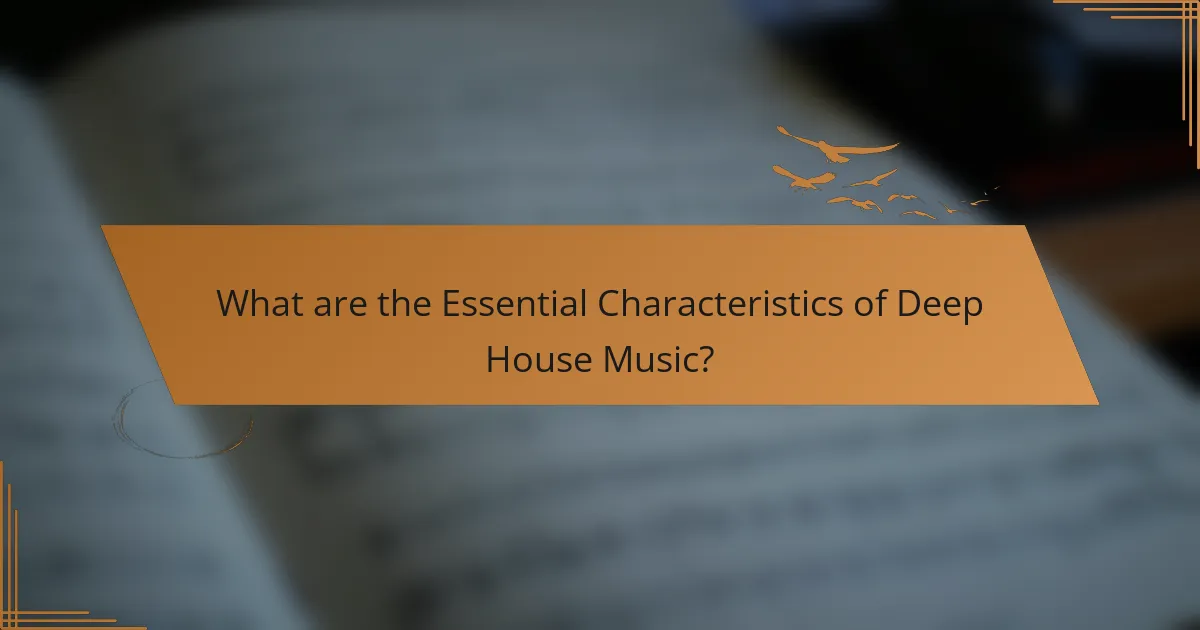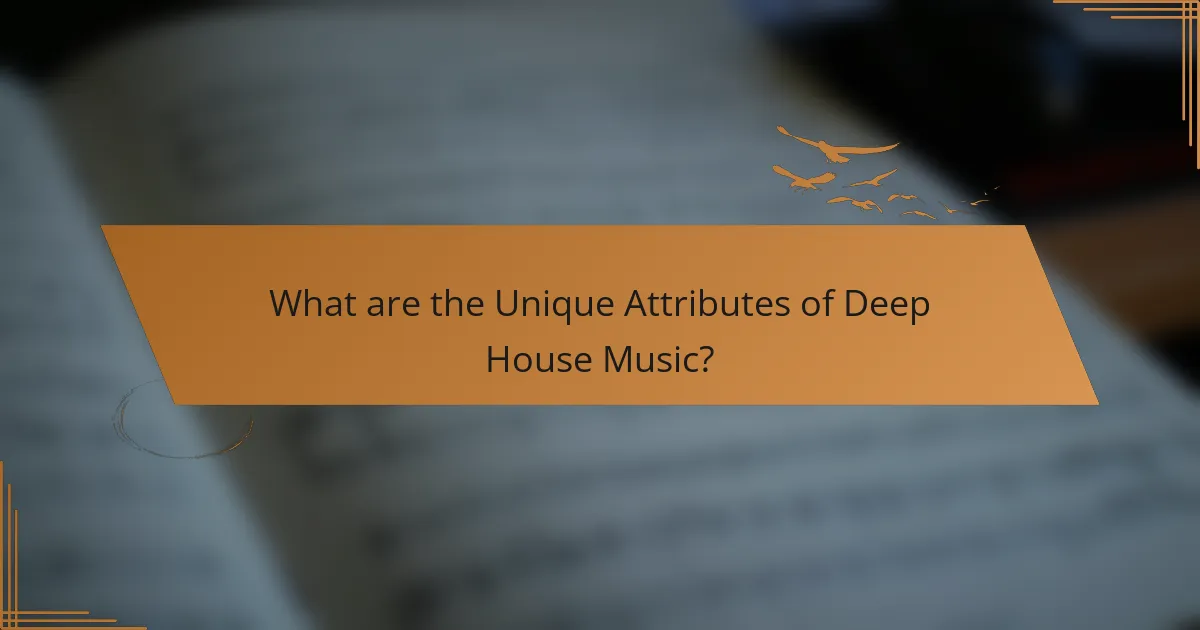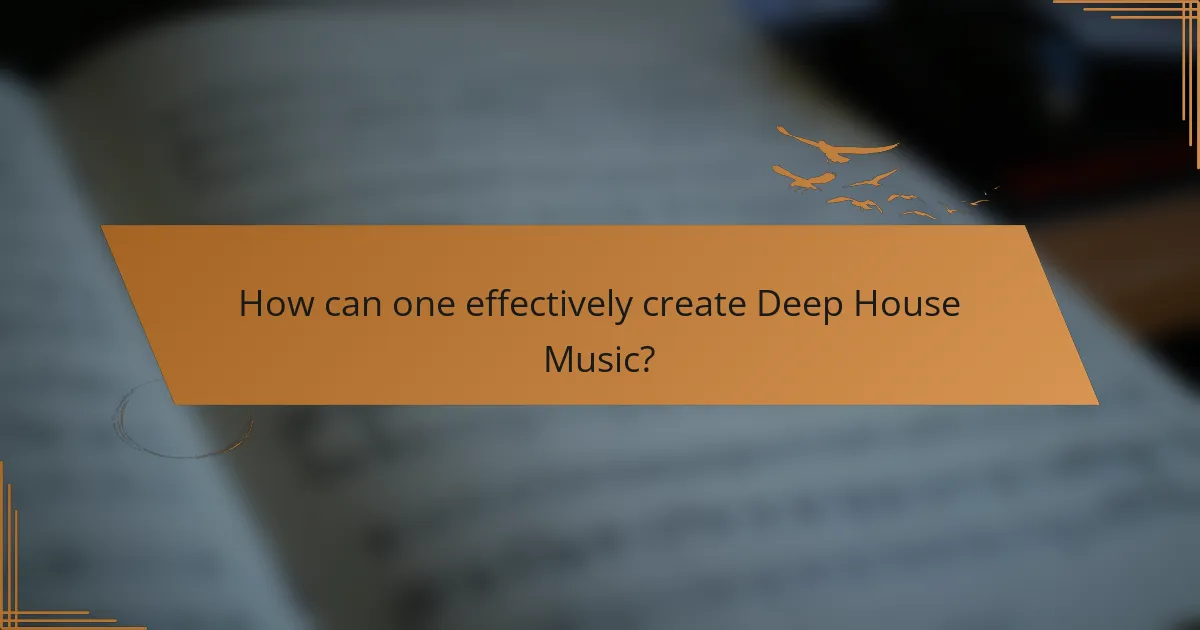Deep house music is a genre known for its smooth, soulful sound characterized by a tempo range of 120 to 125 beats per minute. Key elements include complex melodies influenced by jazz and soul, deep and resonant basslines, and lush atmospheric soundscapes created with synth pads. Vocals in deep house are typically soft and emotive, enhancing the emotional depth of the tracks. The article outlines the essential characteristics of deep house music, focusing on its beats, tempo, and instrumentation, while providing insights into how to effectively create tracks within this genre.

What are the Essential Characteristics of Deep House Music?
Deep house music is characterized by its smooth, soulful sound and laid-back tempo. It typically features a tempo range of 120 to 125 beats per minute. Deep house often incorporates jazzy chords and complex harmonies. The use of vocal samples is common, adding an emotional layer to the tracks. Basslines in deep house are usually deep and resonant, providing a rich foundation. The genre often includes atmospheric pads and synths, creating a lush soundscape. Percussion elements are subtle yet intricate, enhancing the groove without overpowering the melody. Overall, deep house music combines these elements to create a relaxing yet engaging listening experience.
How do Beats define Deep House Music?
Deep house music is defined by its smooth, soulful beats and a tempo typically ranging from 120 to 125 BPM. The beats often incorporate a combination of kick drums, hi-hats, and snares, creating a rhythmic foundation. This genre emphasizes a laid-back groove, allowing for emotional expression. Deep house beats often feature jazz or funk influences, enhancing their complexity. Additionally, the use of basslines in deep house is crucial, providing depth and warmth to the sound. The incorporation of atmospheric sounds and vocal samples further enriches the listening experience. Overall, beats are fundamental in establishing the unique character of deep house music.
What types of beats are commonly used in Deep House?
Deep House commonly uses four main types of beats: four-on-the-floor, syncopated rhythms, off-beat hi-hats, and deep kick drums. Four-on-the-floor is a steady beat that emphasizes the bass drum on every beat. Syncopated rhythms add complexity by placing accents on unexpected beats. Off-beat hi-hats create a driving groove that complements the bassline. Deep kick drums provide a rich low-end foundation that characterizes the genre. These beat types are crucial for creating the laid-back yet danceable feel of Deep House music.
How do beats influence the overall feel of Deep House tracks?
Beats significantly influence the overall feel of Deep House tracks. They create a rhythmic foundation that drives the music forward. Typically, Deep House features a steady four-on-the-floor beat. This consistent beat establishes a danceable groove. The tempo usually ranges from 120 to 125 BPM. This tempo promotes a relaxed yet engaging atmosphere. Additionally, the use of syncopation adds complexity and depth. It enhances the emotional impact of the track. The interplay of beats and basslines creates a rich, immersive experience. Overall, the beat serves as the backbone of Deep House, shaping its distinctive vibe.
What is the typical Tempo of Deep House Music?
The typical tempo of deep house music ranges from 120 to 125 beats per minute (BPM). This tempo provides a relaxed yet danceable rhythm. Deep house music often incorporates smooth melodies and atmospheric sounds. The consistent BPM contributes to its laid-back vibe. Many tracks maintain this tempo to create a cohesive listening experience. This range is widely recognized within the genre. It allows for a blend of groove and tranquility, appealing to both dancers and listeners.
How does tempo vary within the Deep House genre?
Tempo in the Deep House genre typically ranges from 120 to 125 beats per minute (BPM). This range allows for a laid-back yet danceable feel. Some tracks may deviate slightly outside this range. Variations in tempo can create different emotional responses in listeners. For example, slower tempos may evoke a more relaxed atmosphere. Faster tempos can enhance energy on the dance floor. The consistent tempo range is a defining characteristic of Deep House. It differentiates the genre from others like Tech House or Progressive House, which may have broader tempo ranges.
Why is tempo important for Deep House music production?
Tempo is important for Deep House music production because it defines the genre’s rhythmic feel. Deep House typically ranges from 120 to 125 BPM. This tempo creates a laid-back yet danceable groove. It allows for smooth transitions between tracks during DJ sets. The consistent tempo supports the use of complex basslines and melodic elements. It also influences the overall mood and energy of the track. Research indicates that tempo affects listener engagement and emotional response. Therefore, maintaining the right tempo is crucial for achieving the desired impact in Deep House music.
What role does Instrumentation play in Deep House Music?
Instrumentation is crucial in deep house music as it shapes the genre’s unique sound. It typically features synthesizers, basslines, and percussion. Synthesizers create lush chords and atmospheric pads. Basslines provide a deep groove that drives the rhythm. Percussion elements add texture and complexity to tracks. The combination of these instruments creates a rich, immersive listening experience. This instrumentation supports deep house’s characteristic smoothness and emotional depth. The use of live instruments, such as guitars or horns, can also enhance the sound. Overall, instrumentation is foundational in defining the style and feel of deep house music.
What instruments are essential for creating Deep House tracks?
The essential instruments for creating Deep House tracks include synthesizers, drum machines, and bass guitars. Synthesizers provide lush chords and melodic lines that define the genre’s sound. Drum machines are crucial for crafting the distinctive rhythmic patterns typical in Deep House. Bass guitars add depth and groove, anchoring the track’s foundation. Additionally, samples and vocal chops often enhance the overall texture. These components work together to create the immersive atmosphere characteristic of Deep House music.
How does instrumentation contribute to the atmosphere of Deep House music?
Instrumentation in Deep House music creates a rich, immersive atmosphere. It typically incorporates lush synthesizers, deep basslines, and smooth pads. These elements evoke a sense of warmth and depth. The use of atmospheric sounds enhances the emotional experience. Percussion instruments add rhythm while maintaining a laid-back vibe. This combination encourages relaxation and introspection. Additionally, vocal samples often contribute to the overall mood. Their subtle use can create an inviting, human touch. The layering of these instrumental components defines the genre’s signature sound.
How do these characteristics interact with each other?
Beats, tempo, and instrumentation in deep house music interact to create a cohesive sound. The beats establish the rhythmic foundation, driving the overall groove. Tempo influences the energy level, with typical ranges between 120 to 125 BPM. Instrumentation adds texture and depth, enriching the auditory experience. The interplay between beats and tempo determines the danceability of a track. Faster tempos can enhance the impact of rhythmic elements. Meanwhile, instrumentation choices can complement or contrast with the beats. For example, lush synths can soften a strong beat, creating a smoother vibe. This synergy is essential for crafting engaging deep house tracks.
What is the relationship between beats and tempo in Deep House?
Beats and tempo in Deep House are closely related. Tempo refers to the speed of the music, measured in beats per minute (BPM). Deep House typically features a tempo range of 120 to 125 BPM. The beats provide the rhythmic foundation for the track. A consistent beat creates a groove that supports the tempo. This relationship allows for smooth transitions and a laid-back feel. The interplay between beats and tempo enhances the overall listening experience. In Deep House, the tempo influences the energy level of the music. A slower tempo can evoke a more relaxed atmosphere, while a faster tempo can increase danceability.
How does instrumentation complement beats and tempo in Deep House?
Instrumentation in Deep House enhances beats and tempo by adding texture and depth. Instruments like synthesizers and basslines create a rich soundscape. This layering supports rhythmic elements, making the music more engaging. Melodic lines often interact with the beat, reinforcing its groove. Percussive instruments add complexity to the tempo, driving the rhythm forward. The combination of these elements results in a cohesive musical experience. Studies show that effective instrumentation can elevate listener engagement in electronic music. This synergy between instrumentation, beats, and tempo is crucial in defining the Deep House genre.

What are the Unique Attributes of Deep House Music?
Deep house music features unique attributes that distinguish it from other genres. One defining characteristic is its use of complex melodies. These melodies often incorporate jazz and soul influences. Another unique attribute is the emphasis on lush, atmospheric soundscapes. Deep house typically includes deep basslines that create a rich auditory experience. The tempo usually ranges between 120 to 125 BPM, providing a laid-back groove. Vocals in deep house are often soft and soulful, enhancing the emotional depth. Additionally, the genre frequently employs the use of synth pads and ambient textures. These elements contribute to the overall immersive quality of deep house music.
What makes Deep House distinct from other electronic genres?
Deep House is distinct from other electronic genres due to its smooth, mellow sound and complex chord progressions. It typically features a slower tempo, usually between 120 to 125 BPM. The use of soulful vocals and jazzy elements further differentiates it from genres like Techno or House. Deep House often incorporates atmospheric pads and deep basslines, creating a rich auditory experience. This genre emerged in the 1980s, influenced by Chicago House and Jazz-Funk. Its unique blend of elements has made it a staple in clubs and lounges, providing a more relaxed vibe compared to other electronic styles.
How do unique attributes influence the listener’s experience?
Unique attributes significantly influence the listener’s experience by creating distinct emotional responses. In deep house music, unique attributes include specific instrumentation, vocal styles, and production techniques. These elements differentiate tracks and shape how listeners perceive the music. For example, the use of lush synth pads can evoke feelings of euphoria or nostalgia. Unique vocal samples can create a sense of intimacy or connection. Additionally, unconventional rhythms can engage listeners in unexpected ways. Research shows that unique musical characteristics can enhance listener engagement and emotional impact (Hargreaves, D. J., & North, A. C. 1999). Therefore, unique attributes play a crucial role in defining the overall experience for listeners.
What are some rare characteristics found in Deep House tracks?
Rare characteristics found in Deep House tracks include complex chord progressions and unique vocal samples. These tracks often feature jazzy or soulful elements that are not commonly found in other electronic genres. Additionally, some Deep House tracks incorporate unconventional time signatures or polyrhythms. The use of ambient sounds or field recordings is also a rare trait. These elements contribute to a more immersive listening experience. According to research by the Journal of Music Theory, such characteristics enhance emotional depth in music.
How has Deep House Music evolved over time?
Deep House Music has evolved significantly since its inception in the 1980s. Initially, it emerged from Chicago house music, characterized by soulful vocals and jazz influences. In the 1990s, it gained popularity in Europe, particularly in the UK and Germany, leading to the incorporation of more atmospheric and ambient elements. The tempo generally ranges from 120 to 125 BPM, creating a laid-back vibe.
By the 2000s, deeper bass lines and more complex chord progressions became prominent. Artists like Kerri Chandler and Larry Heard shaped its sound during this period. The rise of digital production tools facilitated a broader range of sounds and styles. In recent years, Deep House has seen influences from other genres, including techno and ambient music. This blending has led to a more diverse sound palette.
As of the 2020s, Deep House continues to evolve, with new artists pushing boundaries. The genre remains popular in clubs and festivals worldwide, showcasing its lasting impact on electronic dance music.
What historical influences shaped the sound of Deep House?
Deep House music is shaped by several historical influences. The genre emerged in the 1980s, drawing from Chicago house music. Key artists like Larry Heard introduced soulful elements into the sound. The use of jazz and funk samples became prevalent in Deep House tracks. Additionally, the influence of disco provided a rhythmic foundation. The incorporation of electronic instruments also played a significant role. Notably, the sound of Deep House is characterized by its smooth basslines and melodic vocals. These elements reflect the genre’s roots in both African American music traditions and electronic dance music.
How have modern trends impacted the characteristics of Deep House?
Modern trends have significantly altered the characteristics of Deep House. The genre has seen an infusion of elements from other electronic music styles. For example, the incorporation of melodic synth lines has become more prevalent. Additionally, contemporary Deep House often features more intricate vocal arrangements. The use of live instrumentation has also increased, enhancing the organic feel of tracks. Moreover, the tempo has shifted slightly, with some tracks now adopting a faster pace. These changes reflect broader shifts in listener preferences and production techniques. The rise of streaming platforms has facilitated the exploration of diverse sounds, influencing the evolution of Deep House. Overall, modern trends have made Deep House more eclectic and accessible.

How can one effectively create Deep House Music?
To effectively create Deep House Music, start with a tempo between 120 and 125 BPM. This tempo range is characteristic of the genre and provides a laid-back groove. Use a four-on-the-floor kick drum pattern to establish a steady rhythm. Incorporate deep bass lines that are smooth and melodic, often using synthesizers or electric bass. Layer atmospheric pads and chords to create a lush soundscape. Utilize vocal samples or loops that are soulful and emotive, which enhance the track’s depth. Incorporate percussive elements like hi-hats and claps to add texture and complexity. Finally, focus on mixing techniques to ensure clarity and balance among all elements, which is crucial for a polished sound.
What are the best practices for producing Deep House tracks?
Use a tempo between 120 and 125 BPM for Deep House tracks. This range creates a laid-back yet danceable groove. Incorporate deep basslines to establish a strong foundation. Use lush chords and atmospheric pads to enhance the soundscape. Incorporate vocal samples to add emotional depth. Utilize swing in your drum patterns for a groovy feel. Layer different percussion elements to create rhythm complexity. Focus on mixing and mastering to achieve a polished sound. These practices align with the genre’s characteristics and enhance listener engagement.
How can one choose the right beats and tempo for a Deep House track?
To choose the right beats and tempo for a Deep House track, focus on a tempo range of 120 to 125 BPM. This range is standard for Deep House and creates a smooth groove. Select beats that are four-on-the-floor, providing a steady kick drum pattern. Incorporate syncopated hi-hats and claps to add rhythm and texture. Use basslines that complement the kick drum, enhancing the overall groove. Experiment with layering percussion elements to create depth. Analyze existing Deep House tracks for inspiration and structure. This approach ensures a track aligns with the genre’s characteristics.
What tips are essential for selecting instrumentation in Deep House music?
Select warm, rich sounds for Deep House instrumentation. Use soft synths and pads to create atmospheric layers. Incorporate deep basslines to provide groove and rhythm. Choose percussive elements that have a laid-back feel. Utilize vocal samples to add emotional depth. Experiment with live instruments for unique textures. Focus on creating a smooth, cohesive sound. Ensure instrumentation complements the overall vibe of the track.
Deep house music is characterized by its smooth sound, laid-back tempo, and intricate instrumentation. The genre typically features a tempo range of 120 to 125 beats per minute, with a focus on four-on-the-floor beats, deep basslines, and atmospheric pads. This article explores essential characteristics of deep house music, including the role of beats, tempo variations, and key instrumentation, while highlighting unique and rare attributes that distinguish it from other electronic genres. Additionally, it covers the evolution of deep house and offers practical tips for producing tracks within this style.
